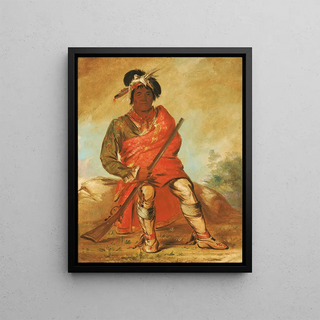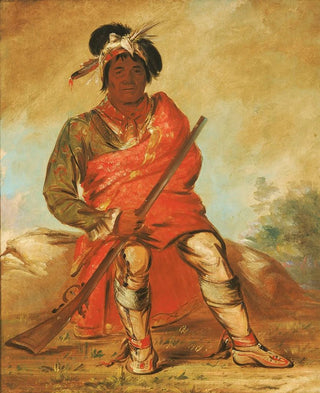Art print Etehe-fixe-co Cerf sans cœur un chef - George Catlin


View from behind

Frame (optional)
In the fascinating world of American art, the piece "Etehe-fixe-co Cerf sans cœur un chef" by George Catlin stands out as a poignant testament to the traditions and beliefs of indigenous peoples. This artwork, which evokes the majesty and spirituality of nature, offers an immersion into the world of the Cheyennes, a tribe of the Great Plains. Catlin, as an artist and ethnographer, was able to capture not only the physical appearance of his subjects but also the essence of their culture, their intimate relationship with the land and animals. The art print of this work invites reflection on identity, memory, and the preservation of traditions in the face of modern challenges.
Style and uniqueness of the work
Catlin's work is distinguished by its unique style, blending realism and romanticism. His compositions are often characterized by vibrant colors and meticulous details that bring the characters and landscapes to life. In "Etehe-fixe-co Cerf sans cœur un chef," the deer, a symbol of power and wisdom, is depicted with such intensity that one almost feels the spiritual strength emanating from it. The flowing lines and dynamic forms demonstrate great technical mastery, while the staging evokes a mystical atmosphere. Catlin does not merely depict a frozen moment in time; he creates a visual narrative that transports the viewer into a world where man and nature coexist in harmony.
The artist and his influence
George Catlin, born in 1796, dedicated his life to exploring and documenting Native American cultures. Traveling across the United States, he encountered numerous tribes, immersing himself in their rituals, beliefs, and ways of life. His work not only helped preserve images of these disappearing cultures but also sparked growing interest in Native American art within 19th-century American society. Catlin was a pioneer in representing indigenous peoples, and his influence endures today, both in the field of art and in cultural studies.

Matte finish

View from behind

Frame (optional)
In the fascinating world of American art, the piece "Etehe-fixe-co Cerf sans cœur un chef" by George Catlin stands out as a poignant testament to the traditions and beliefs of indigenous peoples. This artwork, which evokes the majesty and spirituality of nature, offers an immersion into the world of the Cheyennes, a tribe of the Great Plains. Catlin, as an artist and ethnographer, was able to capture not only the physical appearance of his subjects but also the essence of their culture, their intimate relationship with the land and animals. The art print of this work invites reflection on identity, memory, and the preservation of traditions in the face of modern challenges.
Style and uniqueness of the work
Catlin's work is distinguished by its unique style, blending realism and romanticism. His compositions are often characterized by vibrant colors and meticulous details that bring the characters and landscapes to life. In "Etehe-fixe-co Cerf sans cœur un chef," the deer, a symbol of power and wisdom, is depicted with such intensity that one almost feels the spiritual strength emanating from it. The flowing lines and dynamic forms demonstrate great technical mastery, while the staging evokes a mystical atmosphere. Catlin does not merely depict a frozen moment in time; he creates a visual narrative that transports the viewer into a world where man and nature coexist in harmony.
The artist and his influence
George Catlin, born in 1796, dedicated his life to exploring and documenting Native American cultures. Traveling across the United States, he encountered numerous tribes, immersing himself in their rituals, beliefs, and ways of life. His work not only helped preserve images of these disappearing cultures but also sparked growing interest in Native American art within 19th-century American society. Catlin was a pioneer in representing indigenous peoples, and his influence endures today, both in the field of art and in cultural studies.
12,34 €






